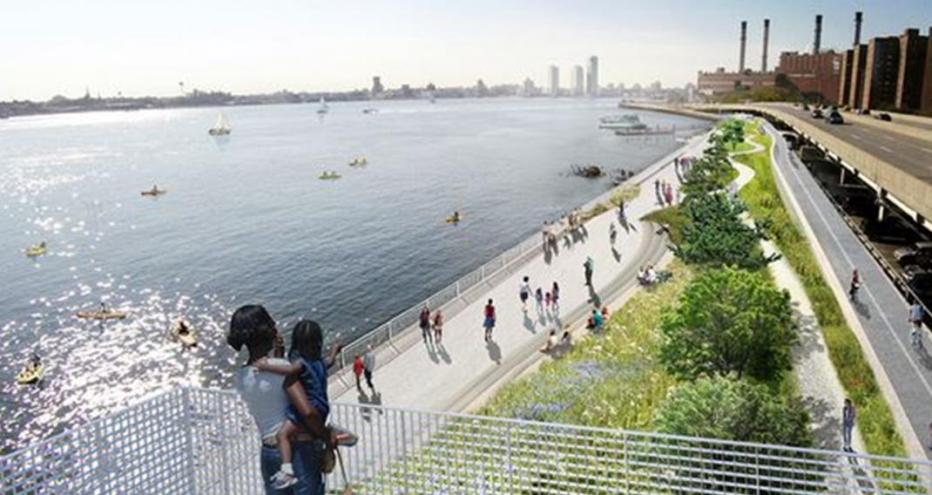
East Side Coastal Resiliency, New York, Rendering courtesy of BIG
The goals of the ESCR project include flood risk reduction, improved waterfront access, and enhanced public spaces. ESCR will not only protect vulnerable areas and critical infrastructure from future flooding but will also make communities safer and more vibrant. The first phase of the ESCR project included a feasibility study and conceptual design for a 2.5-mile segment along the East River from East 25th Street to Montgomery Street. The ESCR flood protection system covers a very dense, vibrant part of New York City (NYC) that runs parallel to NYC’s major eastside highway, the FDR Drive; the project area includes the East River Park waterfront parks, critical infrastructure, and residential and commercial neighborhoods.
Construction will start in Spring 2020. Once complete, the goals of achieving a strengthened coastal defense system that incorporates infrastructure resiliency upgrades, stormwater drainage management improvements, enhanced community access to waterfront parks, and improved park amenities, environmental habitats, and park facilities will be met. ESCR will not only protect the neighborhood and the City’s critical infrastructure from future flooding but will also make the communities safer and more vibrant.
As part of a multi-disciplinary team, Jacobs is one of two design leads and engineers-of-record for the flood protection system. Jacobs provided engineering, investigation, scheduling, and cost estimating services for the flood protection system from feasibility to detailed design. The detailed design of approximately 1.8 miles of the 2.5-mile flood protection system and the redevelopment of nearly 1.2 miles of the existing East River Park esplanade were undertaken by Jacobs as part of the ESCR project.
“Supporting this pivotal program is important to me both personally and professionally. From a resiliency and flood protection standpoint, this infrastructure is much needed for New York City as the impacts of climate change become more pronounced and we see more frequent and intense storms. Personally, as a New Yorker, I’m proud to be part of this program that will deliver a comprehensive flood protection solution that will not only protect the community but also provide enhanced waterfront access and amenities for the neighborhood.”
-
57.5
acres of East River Park will be more resilient
-
2.5
miles of integrated flood protection
-
3
new pedestrian bridges crossing the FDR Drive
-
18
flood gates
In Detail: East Side Coastal Resiliency
The ESCR project received $338 million in Community Development Block Grant Disaster Recovery funding to fund the construction of the flood protection while providing amenity improvements and enhanced community access to the waterfront. The conceptual designs presented a range of multi-functional engineering solutions integrated with urban design features to improve community access and expand the enjoyment of the waterfront parks. The solutions included flood protection structures and foundations, flood-resistant utility tunnels, sewer outfall retrofits to prevent stormwater backflow, sustainable design features, habitat enhancements, park amenities, and pedestrian and bike access paths and bridges.
Improvements will be made to the 57-acre East River Park, 2.8 acre Stuyvesant Cove Park, the 2.4 acres Asser Levy Playground and the 1.3 acres Murphy’s Brothers Playground.
The solutions and their associated construction costs were presented to City agencies, stakeholders, and communities through a robust and comprehensive engagement plan. Community and stakeholder input has influenced the project’s preliminary and final design and construction development processes. Numerous community engagement meetings and workshops ensured that feedback and suggestions drove this interactive and inclusive planning process.













































